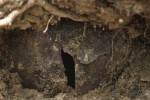 In August of 1832, a group of 57 Irish immigrants started work on a section of the Philadelphia and Columbia railroad known as a cut 20 miles west of Philadelphia. A few weeks later, they were all dead, most probably from cholera. Philip Duffy, the man who hired the Irish workers, had the shanty they slept in burned to keep disease from spreading and the dead buried in the railroad fill. Their families were never notified.
In August of 1832, a group of 57 Irish immigrants started work on a section of the Philadelphia and Columbia railroad known as a cut 20 miles west of Philadelphia. A few weeks later, they were all dead, most probably from cholera. Philip Duffy, the man who hired the Irish workers, had the shanty they slept in burned to keep disease from spreading and the dead buried in the railroad fill. Their families were never notified.
William Watson, chairman of History at Immaculata University, and his brother Frank have been searching for the remains for nigh on a decade. They learned of the story in 2002 from papers their grandfather — a lifelong employee of the railroad — left behind. It wasn’t until March 2009 that they came upon a shin bone, and in the year since then they’ve recovered 7 sets of human remains.
Most surprisingly, the brothers think they’ve actually identified one of the deceased. The manifest of the ship John Stamp, which sailed from Ireland to Philadelphia 4 months before the tragedy, lists 15 possible workers who came from Donegal, Tyrone and Derry counties. One of them was 18-year-old John Ruddy. The Watsons found remains that suited Ruddy’s age, but they also got a hugely lucky break when they found the jaw was missing an upper molar that never formed. This is a rare genetic mutation which members of the Ruddy family in Ireland today share. It will take some months for DNA confirmation, but so far all signs point to Ruddy.
The Watsons and their team think there may have been more than cholera behind all these dead men.
The brothers have long hypothesized that many of the workers succumbed to cholera, a bacterial infection spread by contaminated water or food. The disease was rampant at the time, and had a typical mortality rate of 40 percent to 60 percent.
The other immigrants, they surmise, were killed by vigilantes because of anti-Irish prejudice, tension between affluent residents and poor transient workers, or intense fear of cholera — or a combination of all three.
Now, their theory is supported by the four recovered skulls, which indicate the men probably suffered blows to the head. At least one may have been shot, said Janet Monge, an anthropologist working on the project.
“I don’t think we need to be so hesitant in coming to the conclusion now that violence was the cause of death and not cholera, although these men might have had cholera in addition,” Monge said.
Other artifacts found on the site include working tools, nails, cooking and eating utensils and Irish pipes. Read more about the Duffy’s Cut excavation on the project website.
Nice blog, It made a good read, You write great articles which made good reading .your artilce is about full of Pennsylvania history.And then I will come back and read some more of your blogs, passes the day, I found your blog on yahoo Keep up the excellent work !
Thank you kindly. :hattip:
Oi veh! This could and did happen in America??
It’s not even that surprising that this happened in America. Heck there are people today who probably have considered doing something similar to Mexican immigrants or Muslims.
On a Yahoo story about the planned mosque a few blocks from Ground Zero, multiple people stated flat out that they should burn the mosque, multiple times if needed, of it gets built.
Oh for sure. Industrialization and immigration so often end up in deplorable living conditions/death.
I’m glad these men are finally getting the respectful treatment they deserve.
You bet it did! Catholics were not the first people this country loved to hate, and they won’t be the last … but hate them, they did. Read up on the Know Nothing party.
This is fascinating. I love how much we can learn from forensics today. Also, this is why studying history is so important. We need to learn from the experiences of our immigrant ancestors.
Agreed on all counts. I love that a historian with no particular archaeological field experience was able to learn so much by assembling a team of forensic, dental, bone experts.
You write great articles which made good reading. your artilce is about full of Pennsylvania history.Thank you kindly.